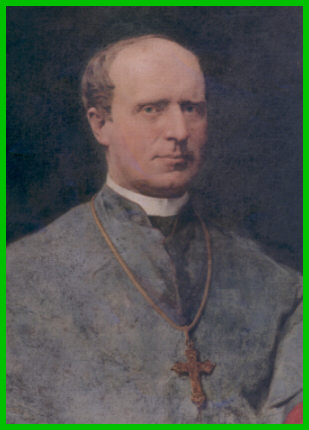

Michael was born in Scariff, County Clare on 17th May 1818; the son of David and Anne (née Corbett) Flannery.
Michael was ordained in Dublin on 5th January 1843, and quickly rose to prominence as secretary to the Society for the Propagation of the Faith, and dean of the Catholic University in 1845.
He joined All Hallows College in Dublin on 25th April 1845 where he was Professor of Moral Theology until he left in 1851 to administer to a rural parish.
Michael was elected Coadjutor Bishop of Killaloe on 5th September 1858, and succeeded to the full bishopric the following summer - the youngest Bishop of Killaloe since the fifteenth century.
As is customary, the bishop was granted a coat of arms for his use in office, and details of the device are provided on the Heraldry webpage.
The Diocese of Killaloe originated in a monastery founded in the sixth century by Saint Lughaidh (nicknamed Molua; 554 - 608). The see was founded about 640 by Pope John IV, who consecrated Saint Flannan (patron saint of Killaloe) as its first bishop. Theodoric, King of Munster and father of Saint Flannan, endowed the see with many estates, and was interred in the abbey.
The years following the Great Famine were marked by widespread poverty and evictions. As a contemporary curate of Nenagh, Fr. Daniel Flannery, once observed ...
"Truly Madame Tussaud's Chamber of Horrors won't be complete till she has an Irish eviction scene, but no tongue can tell, no brush depict, even partially, all the horrors of an Irish eviction."
The Irish clergy frequently intervened and attempted to negotiate financial settlements to prevent families from losing their homes, but the sheer scale of the problem was overwhelming.
Michael initiated plans in 1860 to build a cathedral in Nenagh, County Tipperary, and sent a number of priests, including his cousin Fr. William Flannery, to North America on fund-raising missions. He purchased the site of Nenagh Castle and the surrounding land, and began to restore the castle in order to incorporate it into the new structure. Unfortunately, the development was substantially dependent on American funding, and was brought to an abrupt halt in 1861 by the American Civil War.

In 1862, Fr. Nicholas Power, parish priest of Killaloe, described Michael in private correspondence as ...
"... one of the most gifted Bishops in the Irish Church - a young man, but of uncommon prudence and great piety - he is doing wonders in every part of the Diocese in churches, schools, missions, etc. ..."
Eventually, the workload of a diocese reeling in the aftermath of the Great Famine took its toll on the bishop, and he was stricken with ill health, nervous disorder and acute depression. Directed by the best medical advice of the day, he was transferred to Paris in 1863, where it was thought that a change of air might improve his health - but he never regained his former dynamic vigour. His diocese was administered consecutively be three coadjutor bishops (whom Michael outlived, ironically), until he died in Paris on 19th June 1891. In accordance with his death-bed wishes, his remains were returned to Ireland and he was interred in the Pro-Cathedral in Ennis, County Clare.
[his portrait, illustrated above, is displayed in the hallway of Saint Flannan's College in Ennis; photo courtesy of Pádraig Ó Flannabhra F.I.P.P.A.]